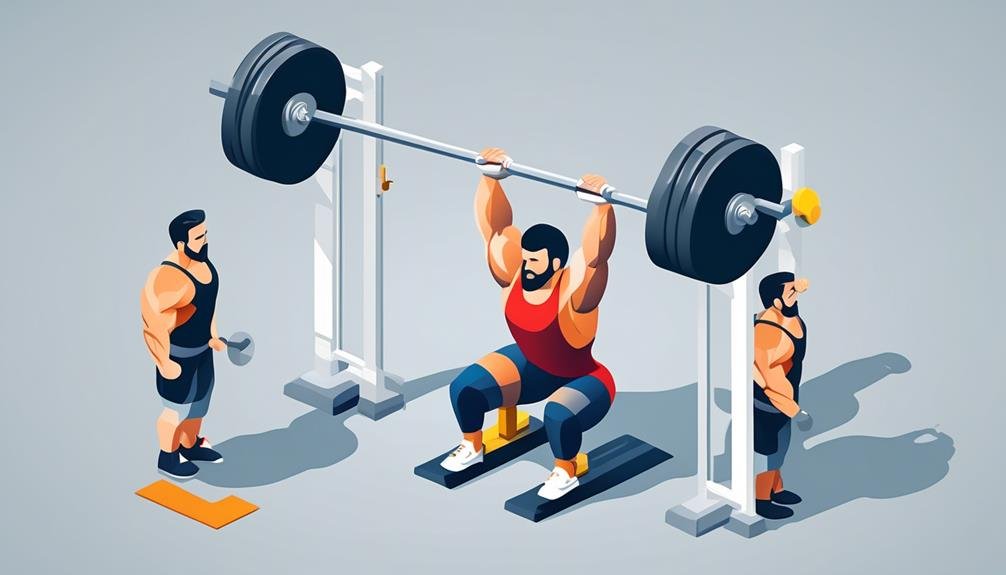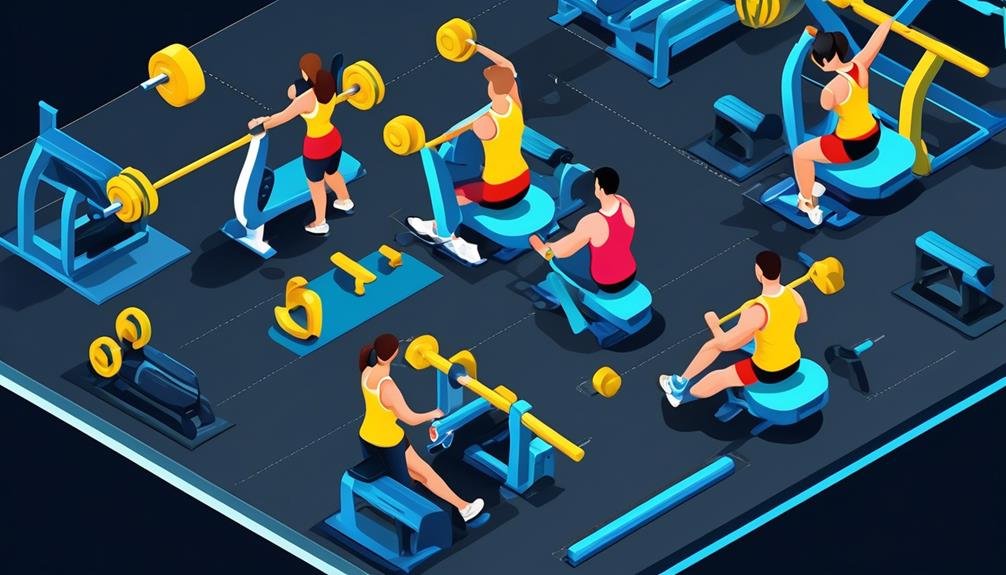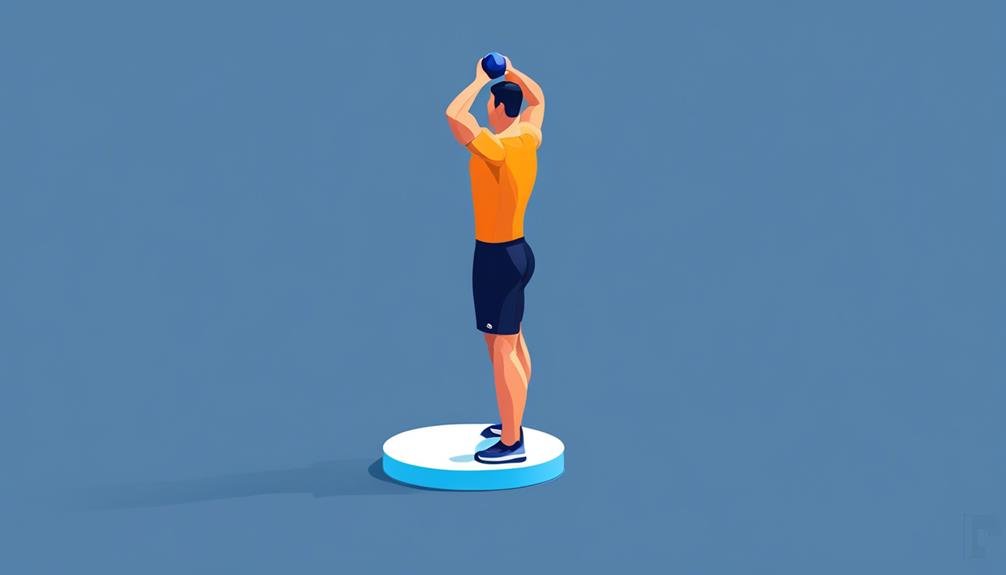Are you tired of feeling stuck in your current weightlifting routine? Ready to challenge yourself and take your strength to the next level? Look no further, as we have the answers you've been searching for.
Whether you're a seasoned lifter or just starting out, progressing into lifting heavier free weights can be a daunting task. But fear not, because in this discussion we will unveil the secrets to safely and effectively increasing your lifting capacity.
So, are you ready to unlock your true potential and reach new heights in your fitness journey?
Key Takeaways
- Accurately assess your current strength level and evaluate performance with current weights.
- Focus on proper form and technique, paying attention to body alignment, engaging the core, and practicing proper breathing techniques.
- Gradually increase weight and intensity of workouts to stimulate muscle growth, trusting the process and staying committed to see progress.
- Incorporate progressive overload principles such as increasing weight, adding more sets and reps, decreasing rest periods, and incorporating advanced techniques to promote muscle adaptation and growth.
Assess Your Current Strength Level
To progress into lifting heavier free weights, it's crucial that you accurately assess your current strength level. This step is essential because it allows you to create a solid foundation for your weightlifting journey. Assessing your strength level will help you determine where you currently stand and where you want to be.
Start by evaluating your performance with the weights you're currently lifting. Pay attention to how easily or difficult it's for you to complete your sets and reps. Are you able to maintain proper form throughout your exercises? Assessing your technique is equally important as it ensures that you're working your muscles effectively and minimizing the risk of injury.
Additionally, consider incorporating strength tests into your assessment. These tests can include exercises such as the bench press, squat, or deadlift. By tracking your progress with these movements, you can identify areas of improvement and set specific goals for yourself.
Focus on Proper Form and Technique
Now that you have accurately assessed your current strength level, it's time to shift your focus towards mastering proper form and technique. This is a crucial step in your journey to safely progress into lifting heavier free weights. Proper form not only ensures maximum efficiency and effectiveness of your workouts, but it also minimizes the risk of injury.
So, let's dive into the four key aspects of proper form and technique that you need to focus on:
- Alignment: Pay attention to your body alignment throughout each exercise. Keep your spine neutral, shoulders back and down, and engage your core. This will help distribute the load evenly and maintain stability.
- Breathing: Don't underestimate the power of proper breathing. Inhale during the eccentric (lowering) phase and exhale during the concentric (lifting) phase. This will provide stability, enhance your performance, and prevent dizziness.
- Range of Motion: Aim for a full range of motion in each exercise, while maintaining control. This ensures that you engage the targeted muscles fully and avoid putting unnecessary strain on your joints.
- Gradual Progression: As you become more comfortable with your form, progressively increase the weight you lift. Gradual progression allows your muscles, tendons, and ligaments to adapt and strengthen, reducing the risk of overuse injuries.
Gradually Increase Weight and Intensity

As you continue to progress in your strength training journey, it is important to gradually increase the weight and intensity of your workouts. This gradual progression is key to building strength and avoiding injuries. By challenging yourself with heavier weights and higher intensity, you will constantly push your limits and stimulate muscle growth.
To help you understand the importance of gradual progression, let's take a look at the table below:
| Week | Exercise | Weight (lbs) | Sets | Reps |
|---|---|---|---|---|
| 1 | Squats | 100 | 3 | 8 |
| 2 | Squats | 105 | 3 | 8 |
| 3 | Squats | 110 | 3 | 8 |
| 4 | Squats | 115 | 3 | 8 |
As you can see, each week you are gradually increasing the weight by 5 pounds. This allows your muscles to adapt and grow stronger over time. It's important to note that this progression may vary depending on your individual fitness level and goals. Listen to your body and make adjustments accordingly.
Remember, Rome wasn't built in a day, and neither will your strength. It takes time and consistent effort to lift heavier weights. Trust the process, stay committed, and you'll see the progress you desire.
Keep pushing yourself, but always prioritize safety and proper form. Happy lifting!
Incorporate Progressive Overload Principles
Gradually increasing the weight and intensity of your workouts is crucial for incorporating progressive overload principles and achieving your strength training goals. By implementing these principles, you'll continuously challenge your muscles, stimulate growth, and improve overall strength.
Here are four key ways to incorporate progressive overload principles into your training:
- Increase the weight: As you become comfortable with a certain weight, it's time to step it up. Gradually increase the weight you lift to ensure that your muscles are being pushed to their limits. This will promote muscle adaptation and growth.
- Add more sets and reps: To further stimulate your muscles, increase the number of sets and reps you perform. This will increase the overall volume of your workout, leading to greater muscle recruitment and development.
- Decrease rest periods: By reducing your rest periods between sets, you can create a more challenging environment for your muscles. This will enhance muscular endurance and promote greater gains in strength.
- Incorporate advanced techniques: Implement techniques such as drop sets, supersets, or pyramids to add variety and intensity to your workouts. These techniques force your muscles to work harder and adapt to new challenges.
Listen to Your Body and Avoid Overtraining

Are you listening to your body and taking the necessary steps to avoid overtraining? It's crucial to pay attention to the signals your body is sending you to prevent pushing yourself too hard. Overtraining occurs when you don't allow sufficient time for recovery and your body becomes overwhelmed by the stress of intense workouts. This can lead to decreased performance, increased risk of injury, and even burnout. To help you better understand the importance of avoiding overtraining, let's take a look at the following table:
| Signs of Overtraining | Prevention Strategies | Recovery Techniques |
|---|---|---|
| Persistent fatigue | Gradually increase | Get enough sleep |
| Decreased performance | rest days | Proper nutrition |
| Frequent injuries | and recovery weeks | Active recovery |
| Mood swings | Listen to your body | Stress management |
| Difficulty sleeping | and take breaks | Relaxation techniques |
Prioritize Recovery and Rest Days
Make sure to prioritize recovery and rest days to maximize your progress and prevent overtraining. When it comes to lifting heavier weights, it's easy to get caught up in the excitement and push yourself too hard. But remember, progress happens during rest, not just during the workout. Here are four key reasons why recovery and rest days should be at the top of your priority list:
- Muscle Repair: Lifting heavy weights creates micro-tears in your muscles. Rest days allow your body to repair and rebuild these muscles, making them stronger and more resilient.
- Injury Prevention: Overtraining can lead to fatigue and decreased coordination, increasing your risk of injury. Taking regular rest days gives your body time to recover, reducing the chance of overuse injuries.
- Mental Refreshment: Physical fitness isn't just about the body; it's also about the mind. Rest days give you a chance to recharge mentally, reducing stress and improving focus for future workouts.
- Performance Improvement: Adequate rest is essential for optimizing performance. When you give your body time to recover, you'll have more energy, strength, and endurance to push yourself during your next workout.
Seek Professional Guidance and Support

To optimize your progress and ensure proper form and technique, seeking professional guidance and support is crucial when it comes to lifting heavier free weights. While you may have a good foundation in weightlifting, there are specific nuances and intricacies that only a trained professional can truly understand and guide you through.
A qualified coach or trainer possesses the expertise and knowledge necessary to help you safely progress and avoid injury. They can assess your current abilities, create a personalized program tailored to your goals, and provide valuable feedback on your technique.
A professional can also help you set realistic goals and provide the accountability you need to stay on track. They understand the importance of gradual progression, ensuring that you don't push yourself too hard and risk setbacks. With their guidance, you can steadily increase your weights and challenge your limits while maintaining proper form. They can also introduce you to various lifting techniques, helping you diversify your workouts and target different muscle groups effectively.
Furthermore, seeking professional guidance and support creates a supportive environment that can enhance your motivation and confidence. Surrounding yourself with like-minded individuals who are committed to their fitness goals can be incredibly inspiring. They can provide encouragement, share their experiences, and offer valuable tips to help you overcome obstacles and reach new heights.
Frequently Asked Questions
How Often Should I Reassess My Strength Level While Progressing Into Lifting Heavier Free Weights?
You should reassess your strength level regularly when progressing into lifting heavier free weights. This will help you track your progress, identify areas for improvement, and ensure you are safely challenging yourself. Keep pushing forward!
Can I Incorporate Other Types of Exercises or Training Methods While Focusing on Proper Form and Technique?
You can definitely incorporate other exercises or training methods while focusing on form and technique. It's important to challenge yourself, but always prioritize proper form to prevent injury and ensure effective progress.
Is It Necessary to Follow a Specific Timeline or Schedule When Gradually Increasing Weight and Intensity?
You don't need a specific timeline or schedule to increase weight and intensity. Listen to your body, push yourself, but always prioritize safety and proper form. Gradually progress and celebrate each milestone along the way!
What Are Some Examples of Progressive Overload Principles That I Can Incorporate Into My Weightlifting Routine?
To safely progress into lifting heavier free weights, incorporate progressive overload principles. Increase weight gradually, add more repetitions or sets, and decrease rest time. Listen to your body, focus on proper form, and don't rush the process. You've got this!
Are There Any Signs or Symptoms I Should Watch Out for to Avoid Overtraining While Lifting Heavier Free Weights?
Listen to your body. If you experience fatigue, muscle soreness that lasts longer than usual, or a decrease in performance, it's a sign to take a step back. Prioritize rest and recovery to avoid overtraining while lifting heavier free weights.
Conclusion
Congratulations on taking the next step in your fitness journey!
By assessing your current strength level, focusing on form and technique, gradually increasing weight, and incorporating progressive overload principles, you're well on your way to safely lifting heavier free weights.
Remember to listen to your body, prioritize recovery, and seek professional guidance when needed.
Keep pushing yourself and reaching new heights in your strength training. You've got this!





